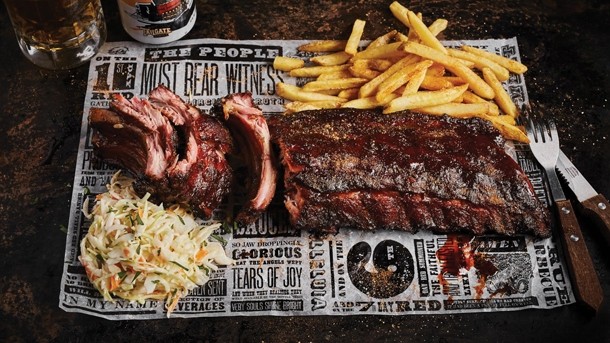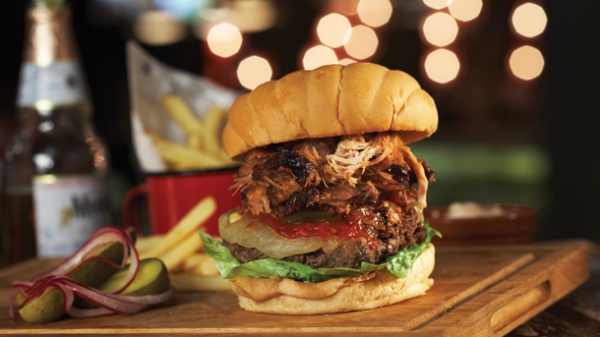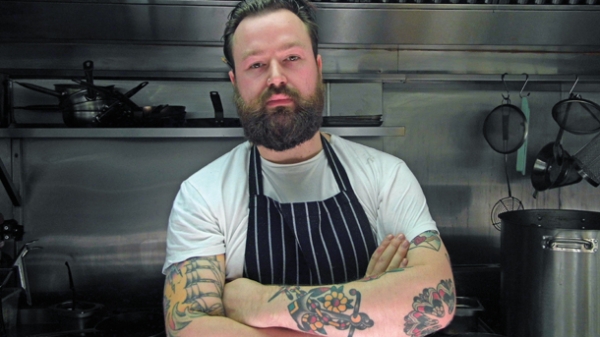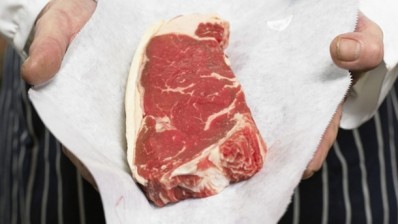MEAT
Vegetarians, avert thine eyes: how meat cookery is evolving in the UK pub sector

Customer tastes in meat are constantly developing and driving change in how operators approach sourcing, cooking and choosing the cuts they use. Indeed, it sometimes seems there’s not a chef who doesn’t boast a preference for ‘alternative’ cuts these days, and even offal is appearing more frequently on pub menus.
But despite this well-publicised swing towards the alternative, chicken was still the best-performing protein in foodservice over the year ending June 2016. The Agriculture & Horticulture Development Board (AHDB) reports that chicken wing servings increased by 7.5%, chicken sandwiches by 5% and burgers by 3.6%.
Beef and lamb saw minor declines, but beef burger serves increased across the eating-out sector. Pork performed very well – 12.7 million more servings of sausages and 12.5 million more pork main meal servings took place than during the previous year (ending June 2015).
But the decade hasn’t been smooth sailing for the meat trade. The great horsemeat scandal of 2013 dented the confidence of many consumers in food businesses across hospitality and retail, placing their sourcing methods and suppliers under intense scrutiny.
It’s taken some time to mitigate this scepticism, Michael Laity, category manager at Brakes explains. “The importance of accountability and the sourcing process of meat and poultry is less prominent than it was a few years ago, following the aftermath of the horsemeat scandal,” he says.
“It is generally accepted with consumers that these factors are a given when it comes to the meat and poultry they purchase.”
Many operators confirm diners are more eager than ever before to ask questions as to where the meat on their plate comes from. In fact, accountability when it comes to providence and sourcing is considered by many as a requirement rather than a bonus, Laity adds.
Brexit
With the reality of Brexit approaching, rising political nationalism could see customers further devoting themselves to domestic produce. But there is potential for uncertainty in the markets to affect operators who buy their meat from international suppliers.
“In the short term, the biggest change to economic metrics has been a steep fall in the value of sterling against the Euro and US dollar,” explains Stewart Batchelor, analyst at AHDB.
“This is important as food is increasingly bought and sold internationally as a commodity and, DEFRA claims, 46% of food consumed in the UK is imported.”
If sterling continues to decline or even remains at the current level, food prices in general look as though they will increase, he continues.
“The trend will be towards [food in pubs] becoming more expensive if it is sourced from outside this country – but the other side of this is the opportunities presented to UK suppliers.”
Hugh Judd, senior foodservice manager at AHDB, points out that the tangible effects on foodservice of Britain’s departure from the EU are yet to be felt. Speculation will reign until Theresa May invokes Article 50 of the Lisbon Treaty.
Curiosity
As well as growing curiosity about where their meat comes from, customers’ tastes have moved westward, across the Atlantic. Glance at a selection of contemporary pub menus and it becomes clear that barbecue culture is en vogue.
Cooking trends around meat and poultry in the UK have become almost synonymous with American methods, Laity confirms. “The concept is primarily around smokehouse and BBQ themes where meat is predominantly slow cooked, while poultry is grilled,” he says.
While a focus on providence and Stateside inspiration are driving how operators cook and present their dishes, cheaper cuts of meat are becoming more popular thanks to their versatility.
Some cheaper cuts such as beef brisket are renowned for how well they lend themselves to now-fashionable cooking methods.
“Brisket, beef cheeks, lamb shank, pork belly, chicken wings and thighs are good examples of this,” confirms Nigel Parkes, purchasing and marketing director at Flagship Europe.
“The raw meat is prepared in a manner that produces quality centre-plate items with slow cooking and sous-vide becoming increasingly popular,” he says. “When cooked like this, the meat is tender, succulent, flavoursome and, thanks to the retention of meat juices throughout the cooking process, the intense natural flavour minimises the need for additional ingredients and flavour enhancers.”
‘Pulled’ meats are, somewhat predictably, still massively in demand. Pulled pork in particular has remained a staple on menus since it hit the food scene earlier in the decade.
It made inroads into the pub sector largely via pop-up traders, who popularised the street-food attitude and aesthetic now aped by chain restaurants and suppliers. “Pulled meats add interest, variety and flavour to plainer dishes, are visually appealing and, above all, versatile – they can be used as a topping, filling or garnish,” Parkes says.
Blade cut
Pulled pork aside, it’s the less commonly used cuts of meat that are securing favour in chef-driven pubs. Laity highlights the beef blade – or ‘flatiron’, as American diners know it – as one cut expanding its profile in the trade. “Traditionally used for mince and dice due to the toughness of the muscle, this cut is now being introduced on steak menus,” he says.
“The other key point as to why this cut is gaining popularity in foodservice is its economy – cheaper than the large majority of other cuts, the blade cut boasts the flavour profile to match almost any other, making it a fantastic prize-fighter on menus.”
Despite the flavour, blade steaks risk becoming unfathomably tough if not given the attention they deserve. “They need to be cooked slowly and must be medium-rare to obtain the ideal texture required,” says Laity. “One method used is to poach the steak in a heat-resistant container for around 20 minutes and finish off quickly in a grill or pan, achieving a texture similar to a fillet or a rib eye.”
Immersive experience
Attracting younger customers has proved challenging for some operators, who have found themselves competing against disruptive businesses such as Deliveroo at a time when research suggests the demographic are increasingly choosing to stay in rather than eat out.
“Insight shows that diners, especially Millennials, are looking to be stimulated by their food choices,” says Louise Stoba, UK BDM for Big Al’s Foodservice, who believes an “immersive” dining experience is as important as the food on offer.
“The trend for food customisation is a quick and easy way for publicans to heighten each and every meal,” she says. “Allowing customers to create their dish, their way – from burgers through to hot dogs and from chicken wings to chilli – meat-based foods can be adapted to suit a wide range of preferences by adding additional toppings, including cheeses, relishes and more.”
She continues: “This creates an almost unlimited menu, meaning diners are less likely to become lethargic about your food offering, causing them to seek out dining experiences elsewhere.”
Sharing is caring
Much to the annoyance of only children everywhere, sharing platters and ‘small plates’ have proved an enduring trend in pubs and restaurants.
“They allow low-risk or low-cost experimentation, which is ideal as people have become more adventurous when trying different food, but don’t want to invest in a product that won’t deliver the experience they want,” says AHDB’s Judd.
He believes the trend is particularly compatible with roasts. “We have focused a significant amount of attention on the mini roast category of late as they tap into this trend to try new cuts and flavours, not typically associated with traditional Sunday roasts,” he says.
This, he adds, can prove to customers that roast meats are a viable – and indeed desirable – dining option all week long rather than just on Sundays. “Roast meats are versatile and ideal options for dish-based cuisines as well,” he says. “They are also popular with chefs as they offer portion control, value for money and versatility.”
A word from the chef
Tom Griffiths is building a reputation as one of the UK’s brightest stars when it comes to meat cookery. His pub pop-up residency Flank opened to rave reviews last year at Indigo Leisure site the Royal Sovereign, in Brighton, before moving to its most recent habitat, the Cow, in nearby Seven Dials.
“Brining is one of the most important things you can do with meat,” he says. “And a good ageing process as well. One of the things I’d recommend chefs do when they get their meat in is to re-hang it – it gives the meat that little bit of extra firmness before going into a brine.”
Griffiths sticks to a 5% brine, adding in aromatics if the cut warrants it, but he makes it clear this is an optional step.
“A good brine on a tough piece of meat will set you up for more tenderness,” he says. “It depends on the cut, but you can, in some cases, brine for 24 hours or more.”
For instance, he says, a great piece of salt beef can be brined for a couple of weeks. It depends on the chef’s desired effect.
Griffiths continues: “The rule of thumb is that with something small like a chicken breast or certain varieties of game, you need to brine for maybe a few hours. But with bigger pieces, you can brine for up to a day.”
Ageing
Once ageing and brining are taken care of, Griffiths turns his mind to what he wants to achieve with the cut. For instance, he says: “With brisket, a good braise where it gets all sticky and falls apart would be ideal if you’re going to put it in a bun, but if you’re going to serve it sliced, you can either roast it at a really low temperature or use a water bath.”
Griffiths is a self-proclaimed barbecue evangelist, swearing by his Kamado grill. “I like to sometimes start on a barbecue and then transfer the meat to a water bath,” he says.
“But then often we’ll just put a piece of meat in there and leave it all day, turning and turning it so it has this amazing glaze and crust and when you slice into it, it is super pink on the inside.”
He echoes Brakes’ Michael Laity’s comments on the potential for chefs who are willing to work with beef blades.
“I would definitely recommend [the blade],” he says. “It’s unbelievable and I think it beats fillet steak by a long shot. As a chef and as a business owner, it’s a lot cheaper to use and in my opinion has a lot more flavour.”
He explains: “Once you take out the bit of membrane running through the middle you are left with these four amazing pieces of meat that just need to be sealed really well in a pan, seasoned well and then when you slice into it, it is just stunning.”
Whole animals
The chef makes a point of buying sections of whole animals, working with local farmers to ensure the quality of the cattle he uses. “You can be looking at less than £3 [per steak],” he says. “So if you are buying a lot of it and using other parts of the cow you can do pretty well. It’s massively economical.”
The last cut Griffiths swears by is short rib, which he cooks sous-vide for 72 hours in a water bath. Following this, he reduces an Asian-inspired, aromatic stock with soy and glucose to make an emulsion and glazes the meat before finishing on a barbecue.
“Traditionally, a lot of people slow cook it,” he explains. “They seal them off and roast them down until they fall apart and they’re sticky, and the bone falls out. But I didn’t do that, I went against the butcher a little bit because I love the fat content on short ribs – the flavour is unbelievable and I wanted to make a steak.”









